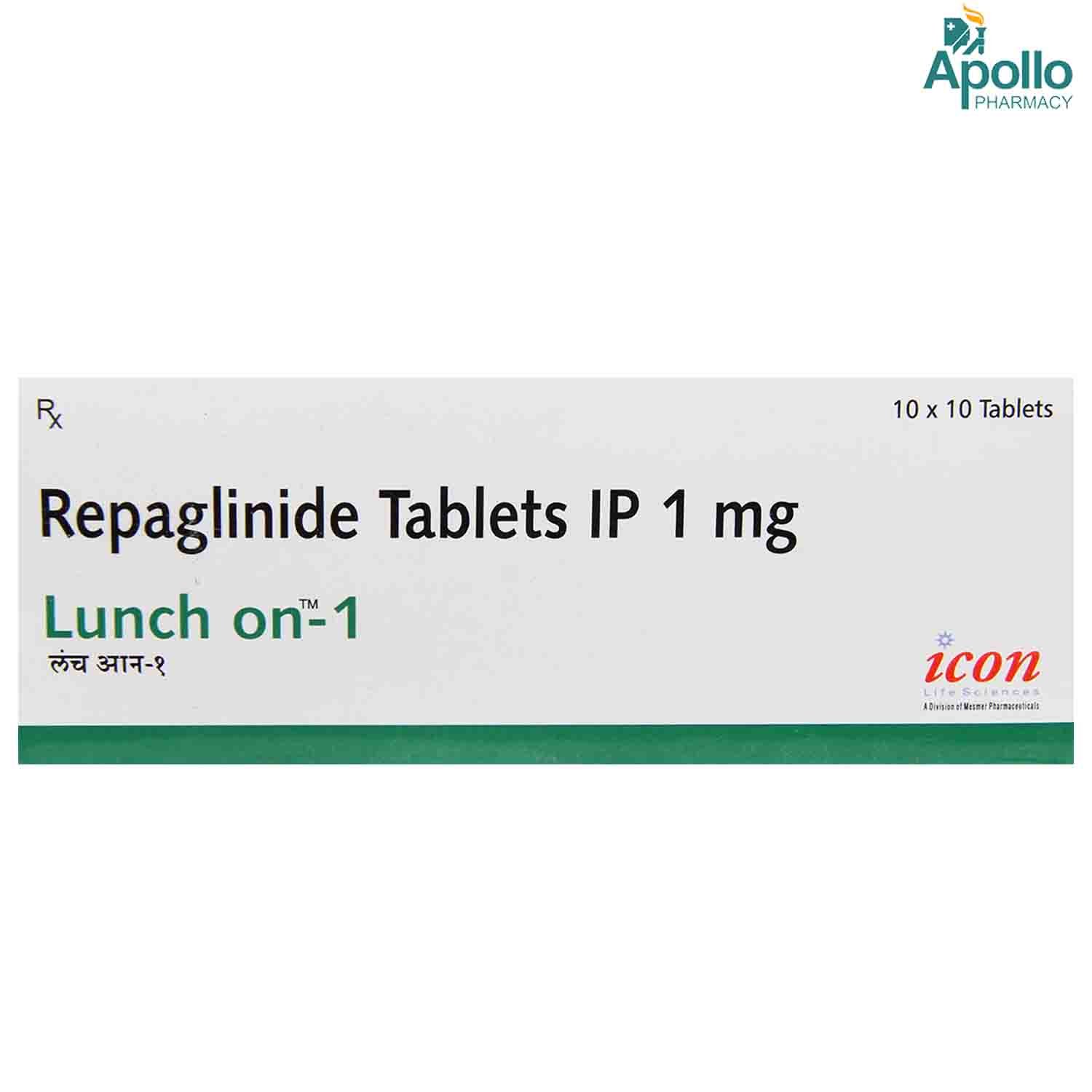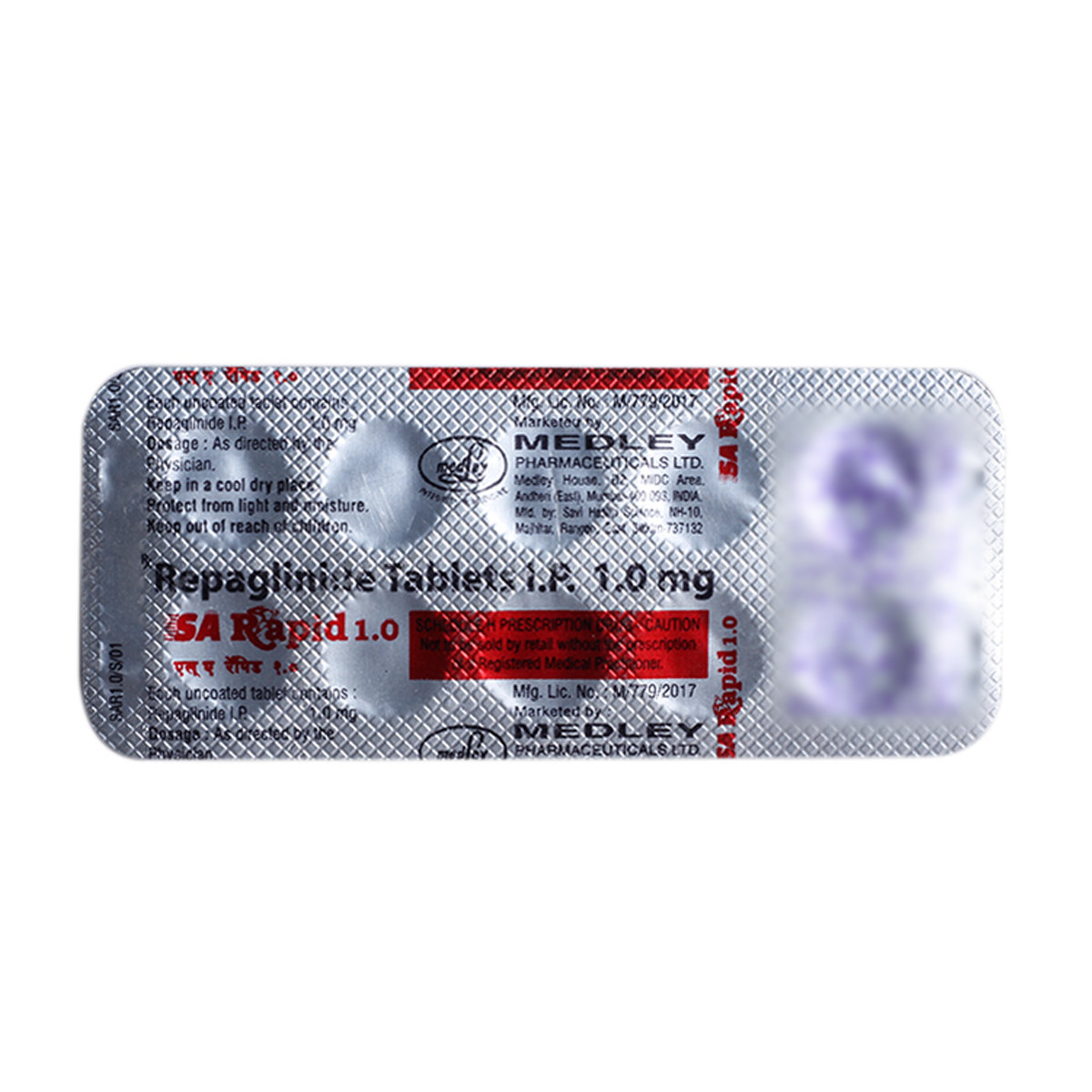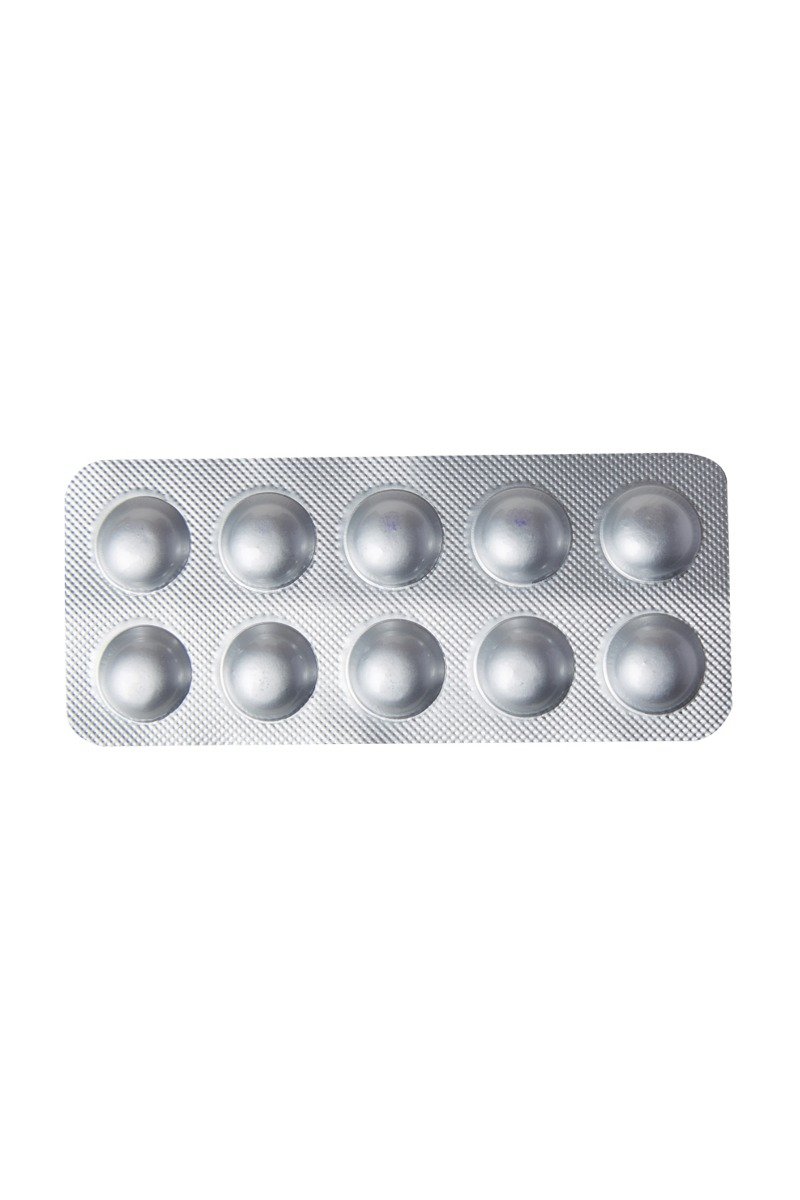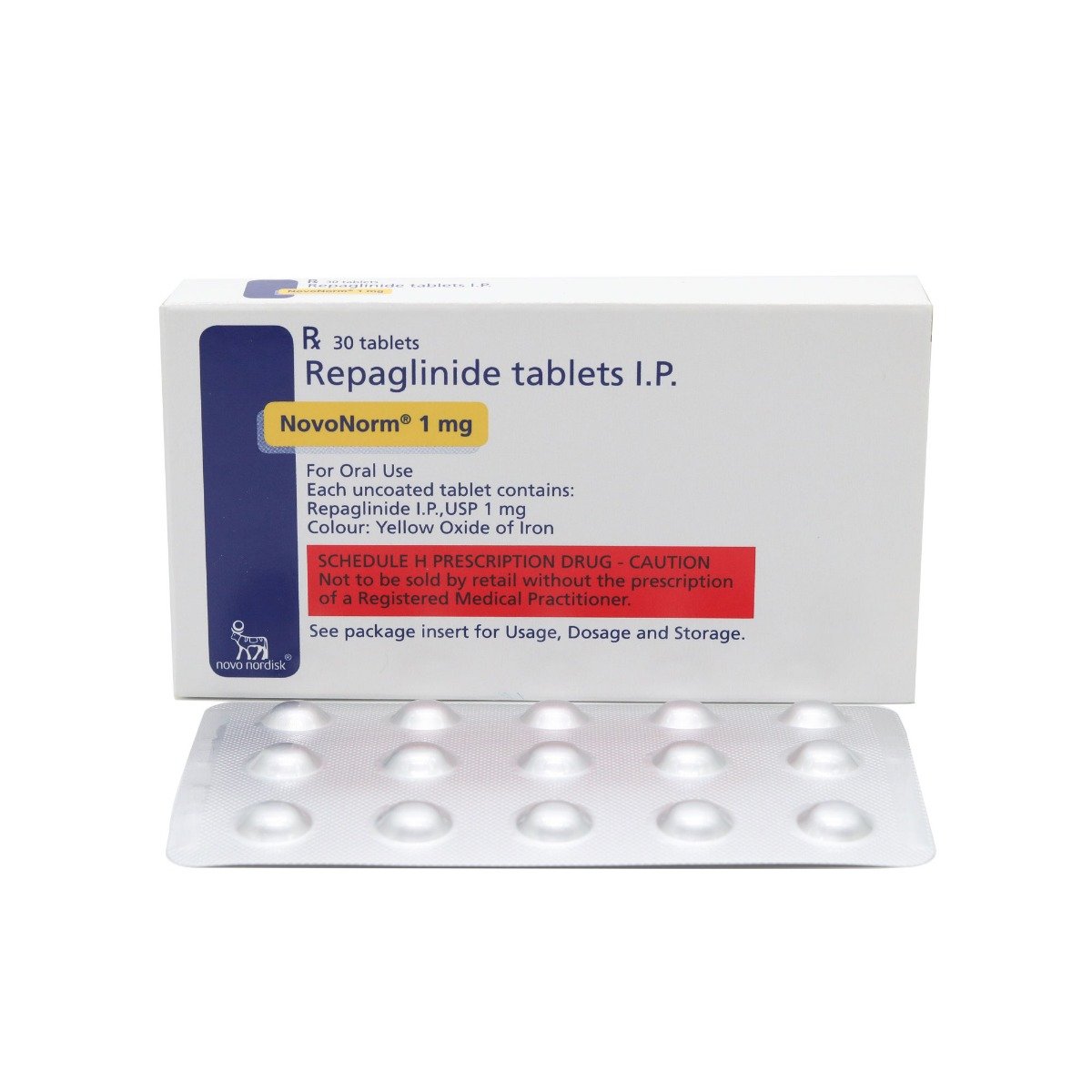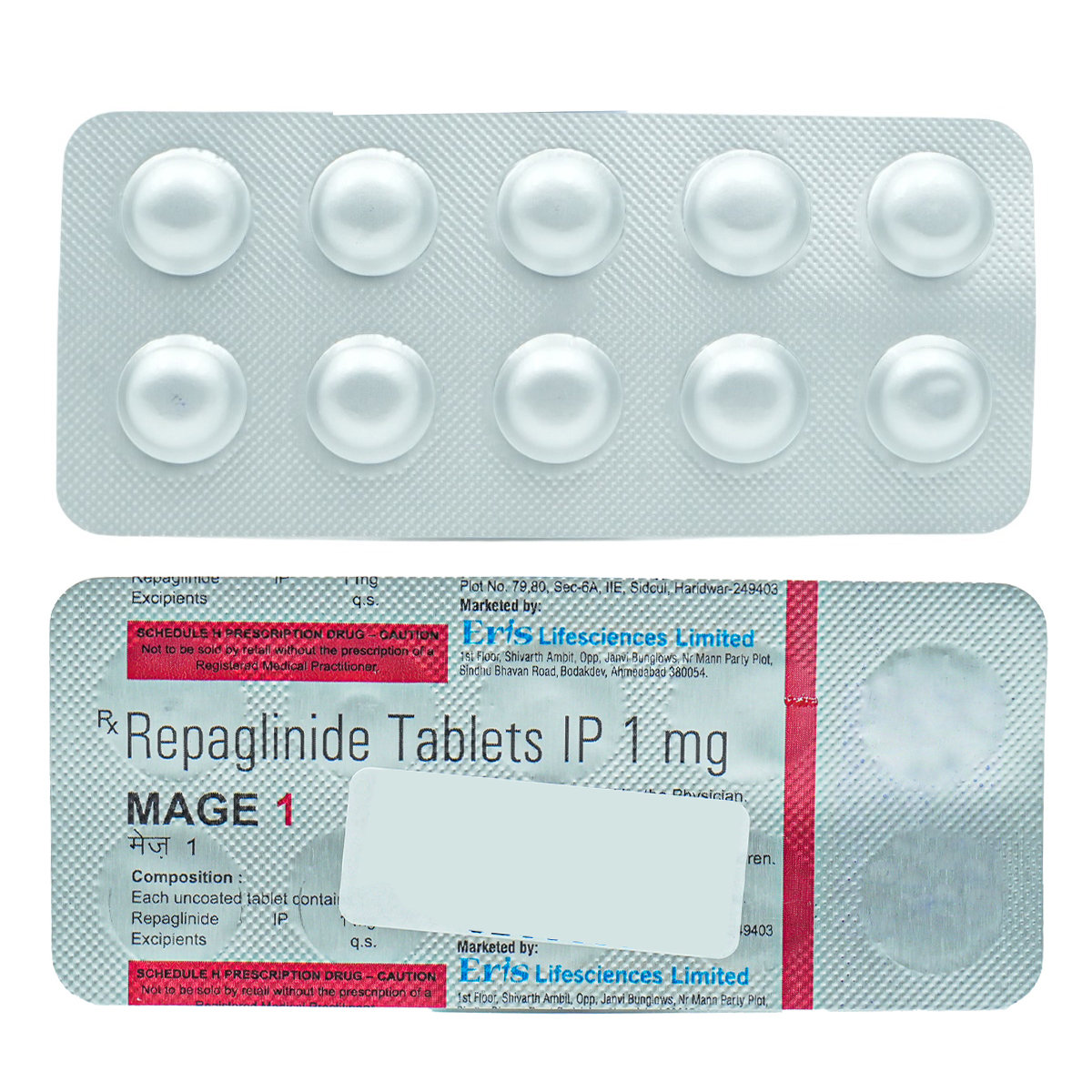RESTRICT 1MG TABLET
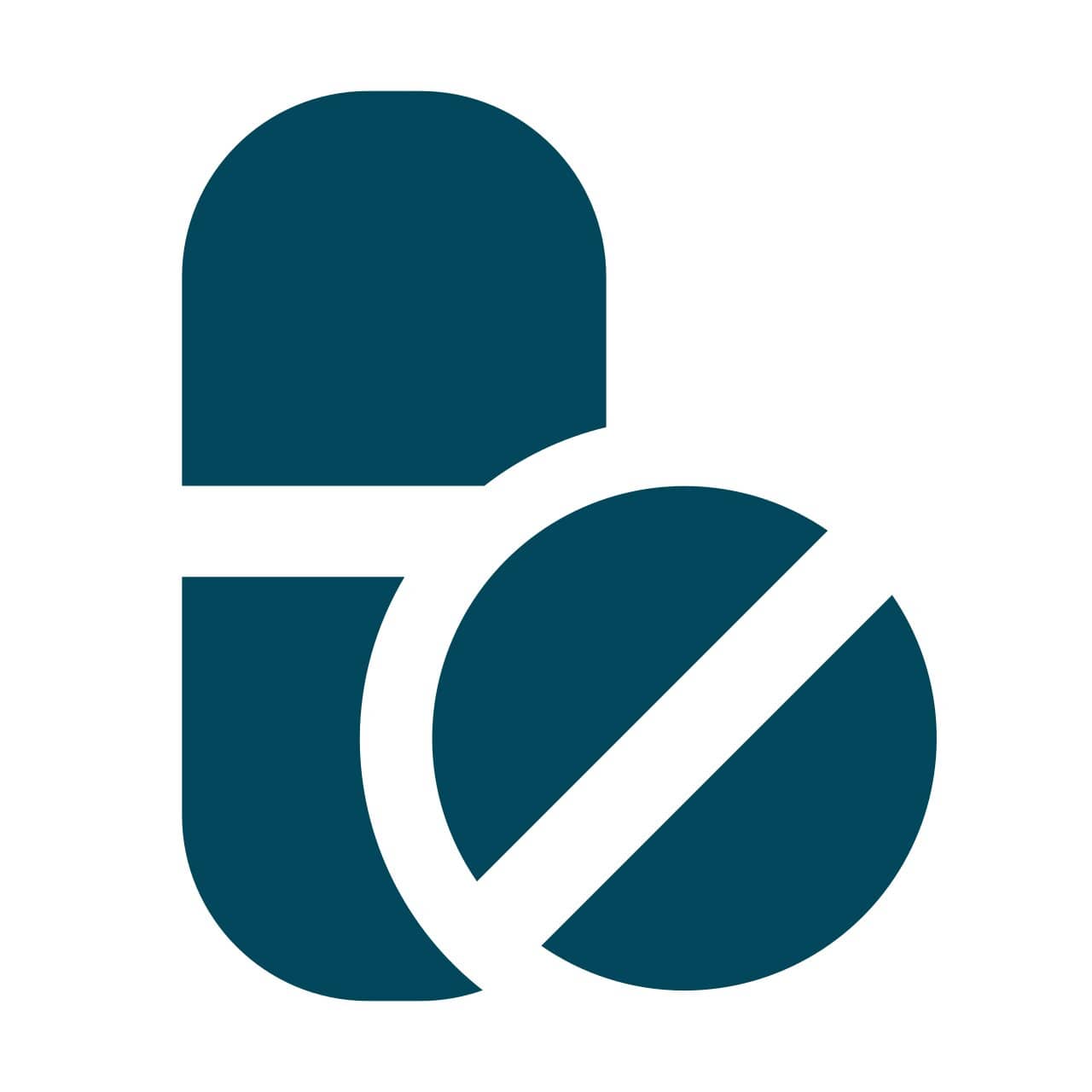

MRP ₹107.5
(Inclusive of all Taxes)
₹16.1 Cashback (15%)
Provide Delivery Location
Online payment accepted
 Prescription drug
Prescription drugWhats That
Composition :
Manufacturer/Marketer :
Consume Type :
Return Policy :
Expires on or after :
About RESTRICT 1MG TABLET
RESTRICT 1MG TABLET belongs to the category of medicines called 'anti-diabetic primarily used for the management and treatment of type 2 diabetes, especially in persons whose sugar levels are too high and cannot be only controlled by dieting and exercising. Type 2 diabetes is a condition that occurs when there is either less insulin or available insulin is not properly utilized by our body cells for lowering raised blood glucose. It is the most common type of diabetes, accounting for around 90% of total diabetes cases found commonly in middle-aged people. So it is also called adult-onset diabetes or non-insulin-dependent diabetes mellitus (NIDDM).
RESTRICT 1MG TABLET contains 'Repaglinide' is a meglitinide that works by increasing the amount of insulin released by the pancreas. It starts acting so quickly on controlling blood sugar levels immediately after a meal. RESTRICT 1MG TABLET may be advised with or without other medications along with diet and exercise to control blood sugar levels.
Your doctor will decide what dose should be taken for better advice, and it can change timely depending upon your condition. In some cases, you may experience headache, stomach pain, a sign of a common cold, diarrhoea, joint pain and back pain. Most of these side effects of RESTRICT 1MG TABLET do not require medical attention and gradually resolve over time. However, if the side effects are persistent, reach out to your doctor.
You should not take RESTRICT 1MG TABLET if you have type 1 diabetes mellitus, renal impairment, metabolic acidosis, including diabetic ketoacidosis (excess acids in your blood), severe kidney, or liver disease. Please inform your doctor if you have any heart disease, are planning to get pregnant, or are breastfeeding. RESTRICT 1MG TABLET should not be stopped even if you feel better, without consulting your doctor as sugar level keeps changing. If you stop taking RESTRICT 1MG TABLET abruptly, it may increase your sugar levels which could further increase the risk of eyesight loss (retinopathy), kidney (nephropathy), and nerve damage (neuropathy).
Uses of RESTRICT 1MG TABLET
Directions for Use
Medicinal Benefits
RESTRICT 1MG TABLET belongs to the group of medicines called “anti-diabetic” indicated in the treatment of type 2 diabetes or non-insulin-dependent diabetes (NIDDM). This medicine is primarily prescribed to persons whose blood sugar levels are high and is even not controlled by diet and exercise alone. RESTRICT 1MG TABLET consists of Repaglinide belongs to a class of meglitinide that works by increasing the amount of insulin released by the pancreas. It starts acting so quickly on controlling blood sugar levels immediately after a meal. RESTRICT 1MG TABLET may be advised with or without other medications along with diet and exercise to control blood sugar levels.
Storage
- If you experience low blood sugar levels, inform your doctor. They will assess the severity and make recommendations for the next actions.
- Your doctor will assess your symptoms, blood sugar levels, and overall health before recommending the best course of action, which may include treatment, lifestyle modifications, or prescription adjustments.
- Follow your doctor's instructions carefully to manage the episode and adjust your treatment plan.
- Make medication adjustments as recommended by your doctor to prevent future episodes.
- Implement diet and lifestyle modifications as your doctor advises to manage low blood sugar levels.
- Monitor your blood sugar levels closely for patterns and changes.
- Track your progress by recording your blood sugar levels, food intake, and physical activity.
- Seek further guidance from your doctor if symptoms persist or worsen so that your treatment plan can be revised.
- Hydrate your body: Drink enough water to prevent dehydration and headaches.
- Calm Your Mind: Deep breathing and meditation can help you relax and relieve stress.
- Rest and Recharge: Sleep for 7-8 hours to reduce headache triggers.
- Take rest: lie down in a quiet, dark environment.
- Cold or warm compresses can help reduce tension.
- Stay Upright: Maintain good posture to keep symptoms from getting worse.
- To treat headaches naturally, try acupuncture or massage therapy.
- Over-the-counter pain relievers include acetaminophen and ibuprofen.
- Prescription Assistance: Speak with your doctor about more substantial drug alternatives.
- Severe Headaches: Seek emergency medical assistance for sudden, severe headaches.
- Frequent Headaches: If you get reoccurring headaches, consult your doctor.
- Headaches with Symptoms: Seek medical attention if your headaches include fever, disorientation, or weakness.
- Inform your doctor about the symptoms you're experiencing due to medication.
- Your doctor may adjust your treatment plan, which could include changing your medication, adding new medications, or offering advice on managing your symptoms.
- Practice good hygiene, including frequent handwashing, avoiding close contact with others, and avoiding sharing utensils or personal items.
- Stay hydrated by drinking plenty of fluids to help loosen and clear mucus from your nose, throat, and airways.
- Get plenty of rest and engage in stress-reducing activities to help your body recover. If your symptoms don't subside or worsen, consult your doctor for further guidance.
- Chest pain may last for a while and needs immediate medical attention as it is a significant health issue to be attended to.
- Take rest and refrain from doing physical activity for a while, and restart after a few days.
- Try applying an ice pack to the strained area for at least 20 minutes thrice a day. Ice pack thus helps reduce inflammation.
- Sit upright and maintain proper posture if there is persistent chest pain. • Use extra pillows to elevate your position and prop your chest up while sleeping.
- Chest pain may last for a while and needs immediate medical attention as it is a significant health issue to be attended to.
- Take rest and refrain from doing physical activity for a while, and restart after a few days.
- Try applying an ice pack to the strained area for at least 20 minutes thrice a day. Ice pack thus helps reduce inflammation.
- Sit upright and maintain proper posture if there is persistent chest pain. Use extra pillows to elevate your position and prop your chest up while sleeping.
- Work with your healthcare provider to identify and avoid allergy triggers
- Always carry your medications or epinephrine auto-injector if prescribed, and ensure it is readily accessible.
- Keep doors or windows closed during an allergy season.
- Use an air conditioner or humidifier to control mold.
- Fix any leaks and clean areas with mold using a chlorine solution.
- Wash sheets, pillowcases, and blankets every week in hot water.
- Wear sunglasses and a mask to reduce exposure to environmental irritants.
- Take off your shoes, change clothes, and shower after being outside.
- Change positions or take a break from activity to relieve symptoms.
- Avoid postures that put a lot of pressure on just one area of the body.
- If you have vitamin deficiency, take supplements or change your diet.
- Exercise regularly like cycling, walking or swimming.
- Avoid sitting with your legs crossed.
- Clench and unclench your fists and wiggle your toes.
- Massage the affected area.
Drug Warnings
RESTRICT 1MG TABLET should not be used in patients with type 1 diabetes or with diabetic ketoacidosis (in this condition, there is too much lactic acid accumulated in the blood). Inform your doctor if you take other antidiabetic drugs to adjust the dosage of RESTRICT 1MG TABLET accordingly. Do not abruptly stop taking RESTRICT 1MG TABLET midway if the doctor did not advise you. RESTRICT 1MG TABLET may cause hypoglycaemia (low blood sugar), hence it is advised to make healthy food with enough calories and avoid heavy exercises. RESTRICT 1MG TABLET is not recommended for use during pregnancy and breastfeeding. Your doctor may advise alternate medications to control your diabetic condition in such cases. RESTRICT 1MG TABLET is not recommended for people younger than 18 years or over 75 years of age. Before you start taking RESTRICT 1MG TABLET, tell your doctor if you have serious heart disease or if you have had a stroke, low blood pressure (hypotension), and severe liver or kidney disease. Avoid alcohol intake while using RESTRICT 1MG TABLET since it may increase the risk of lactic acidosis.
Drug-Drug Interactions
Drug-Drug Interactions
Login/Sign Up
When Restrict 1mg Tablet is taken with Gemfibrozil, the level of Restrict 1mg Tablet in the blood can go up. This can increase the risk or severity of side effects.
How to manage the interaction:
Taking Restrict 1mg Tablet with Gemfibrozil can possibly result in an interaction, it can be taken if a doctor has advised it. However, if you experience sudden dizziness, lightheadedness, fainting, shortness of breath, chest pain or tightness, rapid heartbeat, or memory loss, contact a doctor immediately. Do not discontinue any medications without consulting a doctor.
Coadministration of Restrict 1mg Tablet with Gatifloxacin may sometimes affect blood glucose levels. Both low blood glucose and, less frequently, high blood glucose have been reported.
How to manage the interaction:
Although there is a possible interaction, Restrict 1mg Tablet can be taken with Gatifloxacin if prescribed by the doctor. However, consult the doctor if you experience unusual symptoms. Do not stop using any medications without first talking to your doctor.
Coadministration of Restrict 1mg Tablet with enoxacin can affect blood glucose levels. Both high blood glucose (hyperglycemia) and, to a lesser extent, low blood glucose (hypoglycemia).
How to manage the interaction:
Although taking Restrict 1mg Tablet together with Enoxacin can possibly result in an interaction, they can be taken together if prescribed by your doctor. However, contact a doctor immediately if you experience any symptoms of hypoglycemia(low blood sugar), such as headache, dizziness, drowsiness, anxiety, weakness, tremors, nausea, hunger, sweating, and palpitation and symptoms of hyperglycemia(high blood sugar) such as increased thirst, increased hunger, and increased urination. Do not stop using any medications without first talking to your doctor.
Clopidogrel increases the blood levels of Restrict 1mg Tablet, which results in increased effectiveness of Restrict 1mg Tablet. When these medicines are taken together, you may experience low blood sugar (hypoglycemia).
How to manage the interaction:
Although taking clopidogrel with Restrict 1mg Tablet may result in interaction, it can be taken if prescribed by a doctor. However, if you experience any signs of hypoglycemia (low blood sugar), consult your doctor immediately. Common symptoms of hypoglycemia include headache, dizziness, drowsiness, nervousness, weakness, tremor, nausea, hunger, sweating, and palpitation. It is advised to monitor your blood sugar levels if you experience the above symptoms. Do not discontinue any medication without consulting a doctor.
Coadministration of Restrict 1mg Tablet with levofloxacin can affect blood glucose levels. Both high blood glucose (hyperglycemia) and, to a lesser extent, low blood glucose (hypoglycemia).
How to manage the interaction:
Although concomitant administration of levofloxacin with Restrict 1mg Tablet can result in an interaction, they can be taken if a doctor has advised it. Inform doctor if you experience hypoglycemia (low blood glucose) or hyperglycemia (high blood glucose), or if you have a lack of blood glucose control. Headache, dizziness, sleepiness, anxiety, confusion, a shaking sensation, nausea, hunger, weakness, sweat, palpitation, and fast pulse are all symptoms of hypoglycemia. Hyperglycemia symptoms may include increased thirst, increased appetite, and increased urine. Do not stop using any medications without talking to a doctor.
Taking Restrict 1mg Tablet with cinoxacin can affect blood glucose levels. Both high blood glucose (hyperglycemia) and, to a lesser extent, low blood glucose (hypoglycemia).
How to manage the interaction:
Although taking Restrict 1mg Tablet together with Cinoxacin can possibly result in an interaction, they can be taken together if prescribed by your doctor. However, contact a doctor immediately if you experience any symptoms of hypoglycemia, such as headache, dizziness, drowsiness, anxiety, weakness, tremors, nausea, hunger, sweating, and fast heartbeat. Do not discontinue any medicine without consulting a doctor.
Coadministration of Restrict 1mg Tablet with nalidixic acid can affect blood glucose levels. Both high blood glucose (hyperglycemia) and, to a lesser extent, low blood glucose (hypoglycemia).
How to manage the interaction:
Although taking Restrict 1mg Tablet together with Nalidixic acid can possibly result in an interaction, they can be taken together if prescribed by your doctor. Consult the doctor if you experience symptoms such as nervousness, confusion, headache, dizziness, drowsiness, tremors, nausea, hunger, weakness, perspiration, palpitation, rapid heartbeat, increased urination, increased thirst, and increased hunger. Maintaining blood glucose levels is advised. Do not stop using any medications without talking to a doctor.
Taking Restrict 1mg Tablet with ciprofloxacin can effect blood sugar levels, both hyperglycemia (high blood sugar) and, less frequently, hypoglycemia (low blood sugar).
How to manage the interaction:
Although taking ciprofloxacin and Restrict 1mg Tablet together can possibly result in an interaction, it can be taken if your doctor has prescribed it. However, tell your doctor if you experience hypoglycemia, hyperglycemia, or a decline in blood glucose control. Hypoglycemia can cause headaches, dizziness, sleepiness, anxiety, disorientation, tremors, nausea, hunger, weakness, sweat, palpitations, and a rapid heartbeat. Increased hunger, thirst, and urine are all possible signs of hyperglycemia. Consult your doctor if you experience any of the above symptoms.
Coadministration of Restrict 1mg Tablet with moxifloxacin can affect blood glucose levels. Both high blood glucose (hyperglycemia) and, to a lesser extent, low blood glucose (hypoglycemia).
How to manage the interaction:
Although taking Restrict 1mg Tablet together with Moxifloxacin can possibly result in an interaction, they can be taken together if prescribed by your doctor. However, contact a doctor immediately if you experience any symptoms of hypoglycemia, such as headache, dizziness, drowsiness, anxiety, weakness, tremors, nausea, hunger, sweating, palpitation, or hyperglycemia such as increased urination, increased thrust, or increased hunger. Do not discontinue any medicine without consulting a doctor.
Coadministration of Restrict 1mg Tablet and ciclosporin can increase the blood levels and effects of Restrict 1mg Tablet.
How to manage the interaction:
Although taking Restrict 1mg Tablet together with ciclosporin can possibly result in an interaction, they can be taken together if prescribed by your doctor. However, contact a doctor immediately if you experience headache, dizziness, drowsiness, anxiety, weakness, shaking, nausea, hunger, sweating, and palpitation. Do not discontinue any medicine without consulting a doctor.
Drug-Food Interactions
Drug-Food Interactions
Login/Sign Up
Grapefruit Juice, Grapefruit
How to manage the interaction:
Taking Restrict 1mg Tablet and grapefruit or grapefruit juice together can increase the blood levels and effects of Restrict 1mg Tablet. Avoid the consumption of Grapefruit or grapefruit juice.
Diet & Lifestyle Advise
- Fill your half plate with starchy veggies, a quarter with proteins, and a quarter with whole grain.
- Eat at regular intervals. Do not take the long gap between a meal or snack.
- Monitor your blood sugar level regularly, especially when there are a lot of fluctuations.
- Invest at least 150 min of moderate-intensity physical activity and 15 minutes of high-intensity exercise every week.
- Lose weight gradually to achieve a healthy body mass index (18.5 to 24.9).
- Replace refined carbohydrates containing whole-grain foods and increase intake of fruits and veggies and other fibre-enriched foods.
- Reduce intake of saturated fat (or hidden fats) in food like chips, crisps, pastries, biscuits, and samosas. Choose omega 3 fatty acid-containing oils for daily cooking. You may use palm oil, mustard oil, groundnut oil, rice bran oil, and safflower oil for frying.
- Do not take stress as it may elevate your blood sugar level. You may adopt stress management techniques like mindfulness, yoga, or meditation to control stress-related blood sugar changes.
- Opt for low-fat dairy products (low-fat yoghurt, fat-free milk, and cheese, etc.).
- Keep your blood pressure as normal (120/80) as possible as it reduces the risk of cardiovascular diseases in diabetes patients.
Side Effects of RESTRICT 1MG TABLET
- Headache
- Stomach pain
- Sign of a common cold
- Diarrhoea
- Joint pain
- Back pain
Habit Forming
Therapeutic Class
All Substitutes & Brand Comparisons
RX
Reglinide-1 Tablet 10's
Evarite Healthcare
₹75
(₹6.75 per unit)
30% CHEAPERRX
Lunch On 1 Tablet 10's
Icon Life Sciences
₹89
(₹8.01 per unit)
17% CHEAPERRX
Shortepa-1 Tablet 10's
Aanav Healthcare Pvt Ltd
₹92.5
(₹8.33 per unit)
13% CHEAPER
Product Substitutes
Author Details
We provide you with authentic, trustworthy and relevant information
Drug-Diseases Interactions
Drug-Diseases Interactions
Login/Sign Up
FAQs
RESTRICT 1MG TABLET contains Repaglinide that works by increases the amount of insulin released by the pancreas which prevents blood glucose from rising very high after meals.
Hypoglycemia refers to low blood sugar levels, and it is one of the side effects of RESTRICT 1MG TABLET. Hypoglycemia can occur if you miss or delay your food, drink alcohol, over-exercise, or take other antidiabetic medicine along with this medicine. It is important to monitor blood sugar levels regularly.
Type-2 diabetes generally does not affect healthy children and teens, but it may affect children who are obese, which is also known as Childhood Obesity.
If a person is getting unusually thrust or passing urine frequently more than normal while taking RESTRICT 1MG TABLET, they should tell it to their doctor as it may be a sign that there is too much sugar in their blood and treatment needs to be adjusted. It may also because of dehydration as RESTRICT 1MG TABLET can lead to loss of fluids. Increase intake of fluids, if even then you feel thirsty, please consult your doctor.
Your doctor may suggest you go for a regular test for sugar (glucose) in your blood or urine to monitor if diabetes has controlled or not.
Diabetes is a chronic medical condition that means lifelong, so its treatment should also continue for the whole life, so keep taking RESTRICT 1MG TABLET unless your doctor advises you to stop the medicine.
RESTRICT 1MG TABLET should be used with caution in heart, kidney or liver diseases, breathing problems, blood disorders, dehydration, alcohol use, foot ulcers, nerve damage, low blood pressure and severe infections. RESTRICT 1MG TABLET is contraindicated in patients with renal impairment and diabetic ketoacidosis.
In case you feel that your blood sugar level is going down and you are feeling weak, immediately eat sugar candies or drink sugary beverages. It will help to balance the blood sugar level in your body. So, it is advisable to keep sugar candies with you.
Drug-Drug Interactions Checker List
- AMLODIPINE
- METOPROLOL
- ATENOLOL
- PROPRANOLOL
- BISOPROLOL
- BENAZEPRIL
- ENALAPRIL
- FUROSEMIDE
- DIGOXIN
- ASPIRIN
- OCTREOTIDE
- DANAZOL
- CLARITHROMYCIN
- TRIMETAPHAN
- RIFAMPICIN
- ITRACONAZOLE
- KETOCONAZOLE
- GEMFIBROZIL
- CICLOSPORIN
- PREDNISOLONE
- CLOPIDOGREL
- PHENYTOIN
- CARBAMAZEPINE
- PHENOBARBITAL
Special Advise
- It is advised to monitor your blood sugar levels regularly.
- Keep taking the drug even if you think your blood sugar levels are under control. If you miss a dose, do not take a larger dose, consult your treating physician for advice.
- Take short, frequent meals, avoid prolonged fasting when taking this drug. Beware of hypoglycaemia symptoms include sweating, dizziness, palpitations, shivering, intense thirst, dry mouth, dry skin, frequent urination, etc. Whenever you experience the above-mentioned symptoms, immediately consume 5-6 candies or 3 glucose biscuits or 3 teaspoons of honey/sugar and get in touch with your physician. Make sure to carry these with you at all times, especially for long travels.
- Avoid drinking alcohol while on this drug as it increases the risk of hypoglycaemia (decrease in blood sugar which might be fatal in some cases) and lactic acidosis (when the lactic acid increases in the body, impacting the functioning of various organs in the body).
- Try to quit smoking and reduce carbohydrate-rich food like potato, rice, mangoes, bread, sugar etc.
- Remember, lifestyle modifications are the most important step in controlling blood sugar levels.
Disease/Condition Glossary
Diabetes mellitus 2, also known as adult-onset diabetes, is a metabolic disease that causes high blood sugar levels. It is type 2 diabetes and occurs when the insulin (a hormone produced by the beta cells of the pancreas) is resistant in breaking the glucose to produce energy (insulin resistance) or the pancreas (an organ behind the stomach) produce little or no insulin at all. This disease mostly occurs in people aged above 40 years, but can also occur in childhood based on the risk factors. The treatment includes oral glucose-lowering medicines and insulin shots.

Have a query?
Buy best Diabetics products by
Torrent Pharmaceuticals Ltd
Sun Pharmaceutical Industries Ltd
Eris Life Sciences Ltd
Intas Pharmaceuticals Ltd
Lupin Ltd
Micro Labs Ltd
Mankind Pharma Pvt Ltd
Lloyd Healthcare Pvt Ltd
Alkem Laboratories Ltd
Abbott India Ltd
Glenmark Pharmaceuticals Ltd
Cipla Ltd
Macleods Pharmaceuticals Ltd
Wockhardt Ltd
Dr Reddy's Laboratories Ltd
Primus Remedies Pvt Ltd
USV Pvt Ltd
Aristo Pharmaceuticals Pvt Ltd
Emcure Pharmaceuticals Ltd
Alembic Pharmaceuticals Ltd
Ipca Laboratories Ltd
La Renon Healthcare Pvt Ltd
Ajanta Pharma Ltd
Medley Pharmaceuticals Ltd
East West Pharma India Pvt Ltd
Elbrit Life Sciences Pvt Ltd
Corona Remedies Pvt Ltd
Hbc Life Sciences Pvt Ltd
Sinsan Pharmaceuticals Pvt Ltd
Ranmarc Labs
Mitoch Pharma Pvt Ltd
Zydus Healthcare Ltd
Sanofi India Ltd
Akumentis Healthcare Ltd
Fusion Health Care Pvt Ltd
Unison Pharmaceuticals Pvt Ltd
Jubilant Lifesciences Ltd
Novo Nordisk India Pvt Ltd
Tas Med India Pvt Ltd
Blue Cross Laboratories Pvt Ltd
Msn Laboratories Pvt Ltd
Eswar Therapeutics Pvt Ltd
Indoco Remedies Ltd
Q Check Pharmaceuticals
Alteus Biogenics Pvt Ltd
Anthem Bio Pharma
Franco Indian Pharmaceuticals Pvt Ltd
Systopic Laboratories Pvt Ltd
Panacea Biotec Ltd
Zydus Cadila
Biocon Ltd
Edoc Life Sciences Pvt Ltd
Koye Pharmaceuticals Pvt Ltd
Arkas Pharma Pvt Ltd
Diacardus Pharmacy Pvt Ltd
Elinor Pharmaceuticals (P) Ltd
Remedy Life Sciences Pvt Ltd
Saan Labs
Talent India Pvt Ltd
Jarun Pharmaceuticals Pvt Ltd
Capital Pharma
Shrrishti Health Care Products Pvt Ltd
FDC Ltd
Leeford Healthcare Ltd
Nirvana India Pvt Ltd
Elder Pharmaceuticals Ltd
Eli Lilly and Company (India) Pvt Ltd
Glynis Pharmaceuticals Pvt Ltd
Zuventus Healthcare Ltd
Arrient Healthcare Pvt Ltd
Cadomed Pharmaceuticals India Pvt Ltd
Orris Pharmaceuticals
Akesiss Pharma Pvt Ltd
Bal Pharma Ltd
Biochem Pharmaceutical Industries Ltd
Knoll Healthcare Pvt Ltd
Lippon Pharma Pvt Ltd
Morepen Laboratories Ltd
Neucure Lifesciences Pvt Ltd
Opsis Care Lifesciences Pvt Ltd
Wallace Pharmaceuticals Pvt Ltd
Acmedix Pharma Llp
Converge Biotech Pvt Ltd
Erinyle Pharma
Indiabulls Pharmaceuticals Pvt Ltd
Ozone Pharmaceuticals Ltd
Retra Life Science Pvt Ltd
Alvio Pharmaceuticals Pvt Ltd
Geneaid Pharmaceuticals
Heal (India) Laboratories Pvt Ltd
Olcare Laboratories Pvt Ltd
Vasu Organics Pvt Ltd
Kotak Life Sciences
Lakshya Life Sciences Pvt Ltd
Proqol Health Care Pvt Ltd
Sanz Pharmaceuticals
Daylon healthcare pvt Ltd
Mcronus Lifescience Pvt Ltd
Natco Pharma Ltd
Orsim Pharma
Alcohol
Unsafe
You are recommended not to consume alcohol along with RESTRICT 1MG TABLET to avoid unpleasant side-effects.
Pregnancy
Caution
RESTRICT 1MG TABLET is pregnancy category C drug. As the data around the use of RESTRICT 1MG TABLET in pregnant women is limited, the use of RESTRICT 1MG TABLET in pregnancy is restricted. It is highly recommended to consult your doctor before taking this drug in case you are pregnant.
Breast Feeding
Caution
It is unknown whether RESTRICT 1MG TABLET is excreted in human milk. Please consult a doctor before using RESTRICT 1MG TABLET while breastfeeding.
Driving
Caution
Your driving may be affected if your blood sugar levels are too high or too low. Do not drive or operate machinery if you also experience blurred vision, dizziness or drowsiness due to extremely low or high blood sugar.
Liver
Caution
RESTRICT 1MG TABLET to be taken with caution, especially if you have a history of liver diseases/conditions. The dose may have to be adjusted by your doctor. However, RESTRICT 1MG TABLET is not recommended for severe liver disease.
Kidney
Caution
RESTRICT 1MG TABLET to be taken with caution, especially if you have a history of Kidney diseases/conditions. The dose may have to be adjusted by your doctor. However, RESTRICT 1MG TABLET is not recommended for severe kidney disease.
Children
Unsafe
The safety and efficacy of RESTRICT 1MG TABLET in children have not been established. RESTRICT 1MG TABLET is not recommended in children.
Recommended for a 30-day course: 4 Strips



